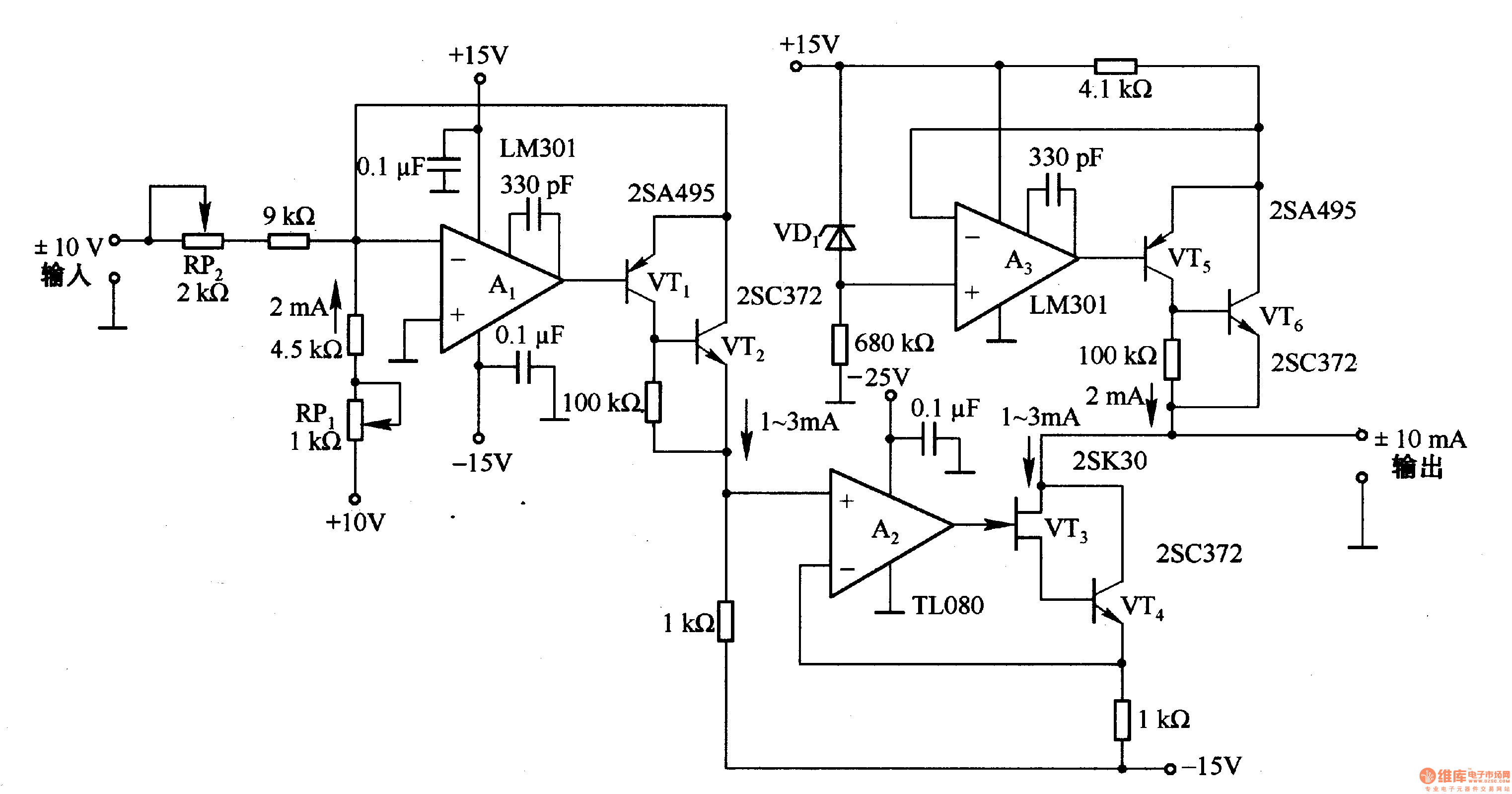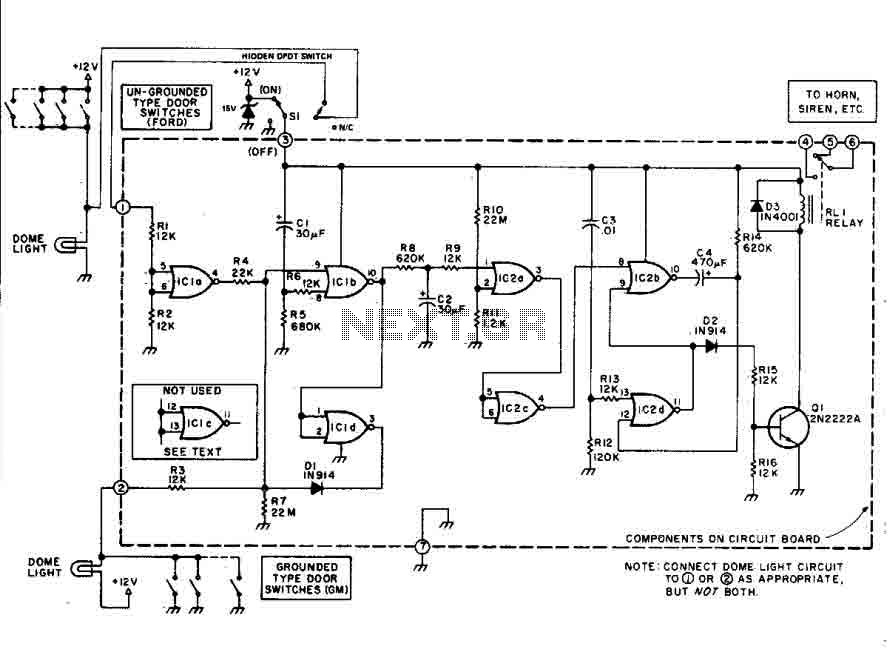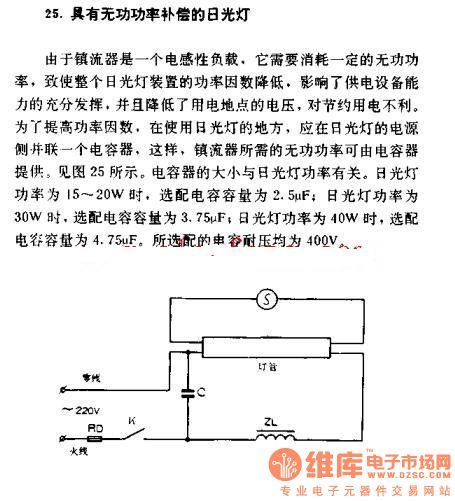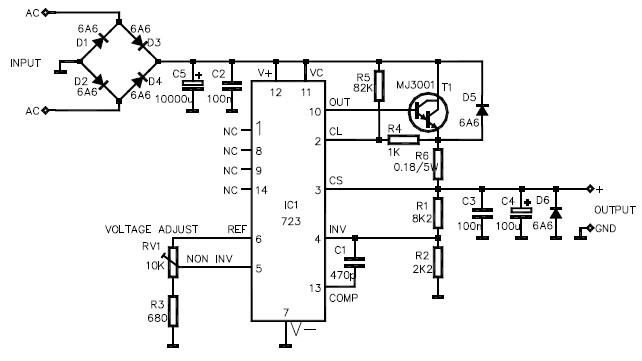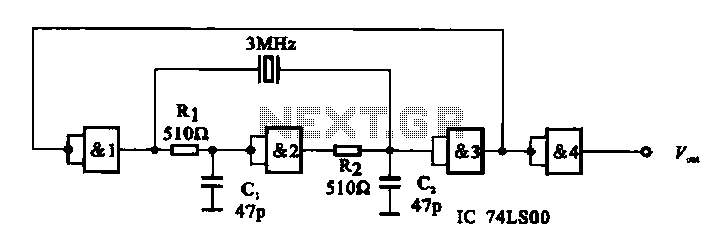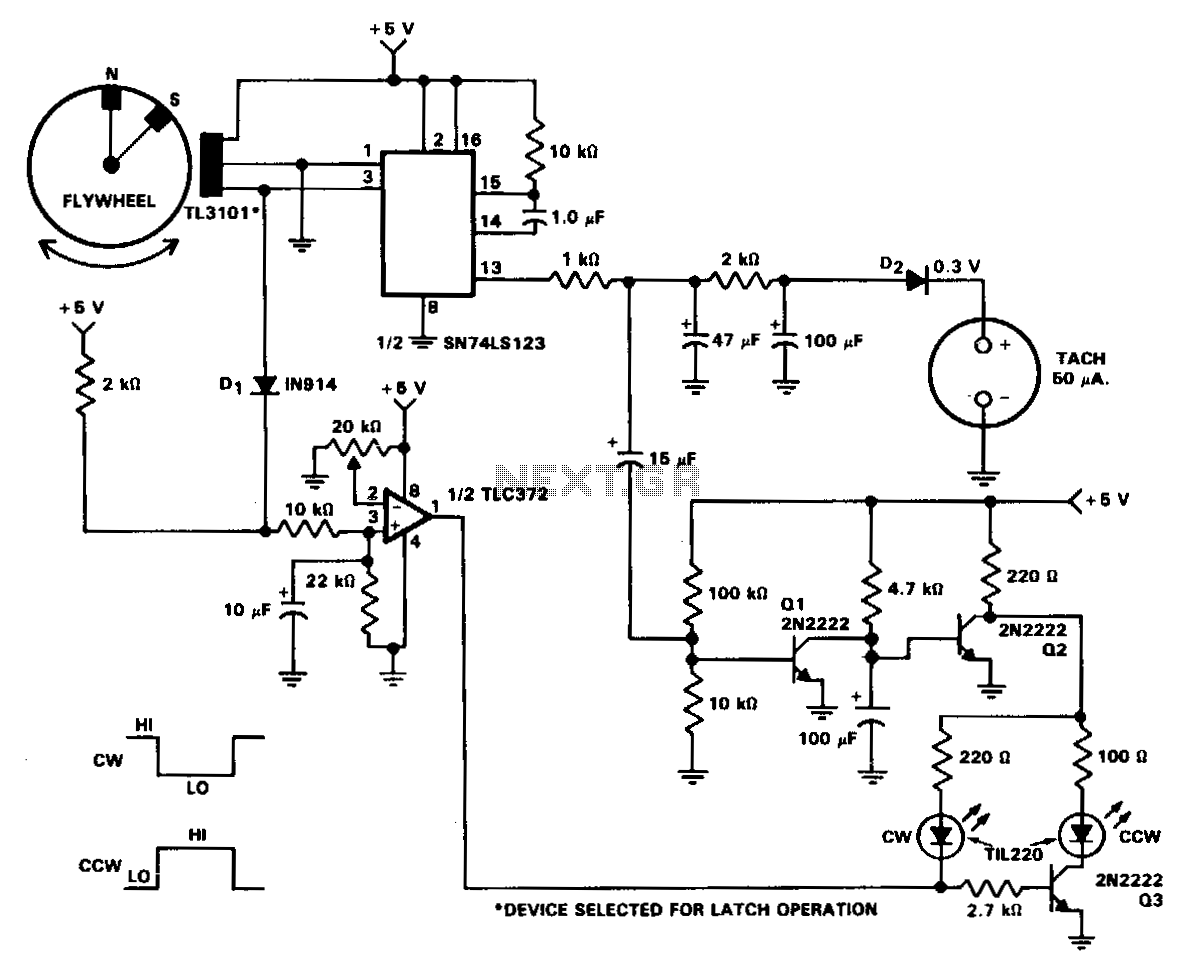
Nestbox Solar Powered Wireless CCTV Camera Circuit
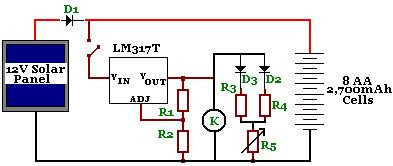
The circuit is designed to power a CCTV camera, provide lighting inside a nestbox, and charge batteries using a photovoltaic (PV) solar panel. It includes a circuit diagram for a solar-powered wireless CCTV camera with battery backup. D1 is a Schottky diode that prevents battery charge from escaping through the solar panel during the night. A suitable diode for this application is the 1N5817, which can handle 1 Amp and 20 Volts with a low voltage drop of less than 0.45 Volts. D2 and D3 are ultrabright LEDs used for illumination within the nestbox. Resistors R3 and R4, each with a resistance of over 400 Ohms, limit the current to the LEDs to a maximum of 30mA, while R5, a 10k variable resistor, allows for dimming the LEDs if necessary. The LM317T is employed as a voltage regulator to reduce the voltage from the solar panel and batteries to just over 8 volts, utilizing resistors R1 (270 Ohm) and R2 (1500 Ohm) to establish this output voltage. The circuit also includes a switch (not labeled) for manual control of the CCTV camera.
The circuit operates effectively as a solar-powered system, ensuring that the CCTV camera remains functional while providing sufficient illumination for the nestbox environment. The Schottky diode D1 is crucial for preventing reverse current flow, thus protecting the battery from discharging through the solar panel at night. The choice of the 1N5817 diode is particularly advantageous due to its low forward voltage drop, which maximizes the efficiency of the solar charging process.
The ultrabright LEDs D2 and D3 serve to provide adequate lighting, which is essential for visibility within the nestbox. The use of resistors R3 and R4 is critical in limiting the current to the LEDs, preventing potential damage from excessive current. The inclusion of the variable resistor R5 allows for user-adjustable brightness, accommodating different lighting conditions or user preferences.
The voltage regulation is managed by the LM317T, which ensures that the output voltage remains stable at just over 8 volts, suitable for the operation of both the CCTV camera and the LED lights. The resistors R1 and R2 are selected to set the desired output voltage, providing a reliable power source. The manual switch incorporated into the circuit design offers flexibility for the user to activate or deactivate the CCTV camera as needed, enhancing the overall functionality of the system.
This circuit exemplifies a well-integrated approach to powering a wireless CCTV camera in a remote location, utilizing renewable energy sources while ensuring operational efficiency and user control.Below is the circuit used to power the CCTV camera, provide lighting inside the nestbox, and charge batteries from a PV solar panel. Circuit diagram for CCTV powered by Solar Panel with Battery Backup Nestbox Solar Powered Wireless CCTV Camera Circuit D1 is a Schottky Diode used to prevent battery charge escaping through the solar panel at night.
Something like a 1N5817 (1 Amp 20 Volt diode) will do the job and it has a very low voltage drop of under 0. 45 Volts. D2 and D3 are ultrabright LEDs used to illuminate the inside of the nestbox. R3 and R4 are resistors chosen (400+ Ohms) to ensure that no more than 30mA of current gets to the sensitive LEDs, with R5 (a 10k variable resistor) used to increase the resistance and therefore dim the LED s if they are too bright.
The LM317T is a voltage regulator * used to bring the voltage of the solar panel and batteries down to just over 8 volts using resistors R1 (270 Ohm) and R2 (1500 Ohm) to set this value. K is the wireless CCTV camera. A switch (not labelled) is used to manually turn the camera on and off as required. 🔗 External reference
The circuit operates effectively as a solar-powered system, ensuring that the CCTV camera remains functional while providing sufficient illumination for the nestbox environment. The Schottky diode D1 is crucial for preventing reverse current flow, thus protecting the battery from discharging through the solar panel at night. The choice of the 1N5817 diode is particularly advantageous due to its low forward voltage drop, which maximizes the efficiency of the solar charging process.
The ultrabright LEDs D2 and D3 serve to provide adequate lighting, which is essential for visibility within the nestbox. The use of resistors R3 and R4 is critical in limiting the current to the LEDs, preventing potential damage from excessive current. The inclusion of the variable resistor R5 allows for user-adjustable brightness, accommodating different lighting conditions or user preferences.
The voltage regulation is managed by the LM317T, which ensures that the output voltage remains stable at just over 8 volts, suitable for the operation of both the CCTV camera and the LED lights. The resistors R1 and R2 are selected to set the desired output voltage, providing a reliable power source. The manual switch incorporated into the circuit design offers flexibility for the user to activate or deactivate the CCTV camera as needed, enhancing the overall functionality of the system.
This circuit exemplifies a well-integrated approach to powering a wireless CCTV camera in a remote location, utilizing renewable energy sources while ensuring operational efficiency and user control.Below is the circuit used to power the CCTV camera, provide lighting inside the nestbox, and charge batteries from a PV solar panel. Circuit diagram for CCTV powered by Solar Panel with Battery Backup Nestbox Solar Powered Wireless CCTV Camera Circuit D1 is a Schottky Diode used to prevent battery charge escaping through the solar panel at night.
Something like a 1N5817 (1 Amp 20 Volt diode) will do the job and it has a very low voltage drop of under 0. 45 Volts. D2 and D3 are ultrabright LEDs used to illuminate the inside of the nestbox. R3 and R4 are resistors chosen (400+ Ohms) to ensure that no more than 30mA of current gets to the sensitive LEDs, with R5 (a 10k variable resistor) used to increase the resistance and therefore dim the LED s if they are too bright.
The LM317T is a voltage regulator * used to bring the voltage of the solar panel and batteries down to just over 8 volts using resistors R1 (270 Ohm) and R2 (1500 Ohm) to set this value. K is the wireless CCTV camera. A switch (not labelled) is used to manually turn the camera on and off as required. 🔗 External reference
Warning: include(partials/cookie-banner.php): Failed to open stream: Permission denied in /var/www/html/nextgr/view-circuit.php on line 713
Warning: include(): Failed opening 'partials/cookie-banner.php' for inclusion (include_path='.:/usr/share/php') in /var/www/html/nextgr/view-circuit.php on line 713
